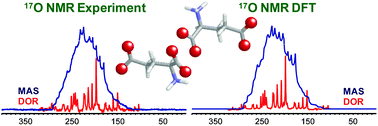Ultra-high resolution 17O solid-state NMRspectroscopy of biomolecules: A comprehensive spectral analysis of monosodium L-glutamate·monohydrate†
Abstract

* Corresponding authors
a
Department of Physics, University of Warwick, Coventry, United Kingdom
E-mail:
M.E.Smith.1@warwick.ac.uk, alan.wong@cea.fr, R.Dupree@warwick.ac.uk
Fax: +44 (0)2476 1 50897
Tel: +44 (0)2476 5 22380+33 (0)1 69 08 41 05+44 (0)2476 523403
b CEA Saclay, DSM, IRAMIS, UMR CEA/CNRS no 3299—SIS2M, Laboratoire Structure et Dynamique par Résonance Magnétique, Gif-sur-Yvette Cedex, France
c University of Oxford, Department of Materials, Parks Road, Oxford, United Kingdom
d Biochemistry Department, University of Oxford, South Parks Road, Oxford, United Kingdom
e National Institute for Chemical Physics and Biophysics, Akadeemia Tee 23, Tallinn, Estonia

 Please wait while we load your content...
Something went wrong. Try again?
Please wait while we load your content...
Something went wrong. Try again?
A. Wong, A. P. Howes, J. R. Yates, A. Watts, T. Anupõld, J. Past, A. Samoson, R. Dupree and M. E. Smith, Phys. Chem. Chem. Phys., 2011, 13, 12213 DOI: 10.1039/C1CP20629J
To request permission to reproduce material from this article, please go to the Copyright Clearance Center request page.
If you are an author contributing to an RSC publication, you do not need to request permission provided correct acknowledgement is given.
If you are the author of this article, you do not need to request permission to reproduce figures and diagrams provided correct acknowledgement is given. If you want to reproduce the whole article in a third-party publication (excluding your thesis/dissertation for which permission is not required) please go to the Copyright Clearance Center request page.
Read more about how to correctly acknowledge RSC content.
 Fetching data from CrossRef.
Fetching data from CrossRef.
This may take some time to load.
Loading related content
